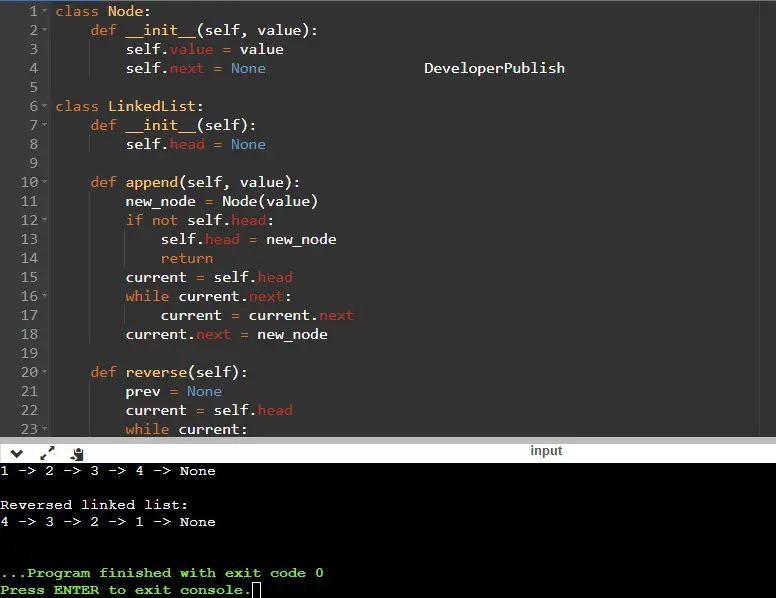Python Program to Reverse a Linked List
A linked list is a data structure consisting of a sequence of nodes. Each node contains an element (or data) and a reference (or link) to the next node in the sequence. Singly linked lists have nodes that only point to the next node, creating a linear structure. Reversing a linked list involves changing the order of these pointers to flip the sequence of nodes.
Problem Statement
You are given a singly linked list, and you need to write a Python program to reverse the order of its elements.
Python Program to Reverse a Linked List
class Node:
def __init__(self, value):
self.value = value
self.next = None
class LinkedList:
def __init__(self):
self.head = None
def append(self, value):
new_node = Node(value)
if not self.head:
self.head = new_node
return
current = self.head
while current.next:
current = current.next
current.next = new_node
def reverse(self):
prev = None
current = self.head
while current:
next_node = current.next
current.next = prev
prev = current
current = next_node
self.head = prev
def display(self):
current = self.head
while current:
print(current.value, end=" -> ")
current = current.next
print("None")
# Create a linked list
linked_list = LinkedList()
linked_list.append(1)
linked_list.append(2)
linked_list.append(3)
linked_list.append(4)
print("Original linked list:")
linked_list.display()
# Reverse the linked list
linked_list.reverse()
print("\nReversed linked list:")
linked_list.display()
How it Works
- Node and LinkedList Classes:
- The program starts by defining two classes:
NodeandLinkedList. - The
Nodeclass represents individual nodes in the linked list. Each node has avalueand a reference to thenextnode in the list. - The
LinkedListclass manages the linked list. It has methods to append nodes to the end of the list, display the list, and most importantly, thereversemethod to reverse the list.
- The program starts by defining two classes:
- Creating the Linked List:
- An instance of the
LinkedListclass calledlinked_listis created. - Elements (values) are appended to the linked list using the
appendmethod. This method creates a newNodewith the given value and appends it to the end of the list.
- An instance of the
- Displaying the Original Linked List:
- The linked list is displayed using the
displaymethod. This method iterates through the linked list and prints the values of each node.
- The linked list is displayed using the
- Reversing the Linked List:
- The crucial part is the
reversemethod in theLinkedListclass. - The method initializes two pointers,
prevandcurrent, both initially set toNoneand the head of the linked list, respectively. - It then iterates through the linked list:
- The
next_nodevariable is used to temporarily store the reference to the next node. - The
current.nextpointer is reversed to point to the previous node (prev). - The
prevpointer is moved to the current node. - The
currentpointer is moved to the next node (stored innext_node).
- The
- The result of this process is a reversal of the pointers within the linked list.
- The crucial part is the
- Displaying the Reversed Linked List:
- After reversing the linked list using the
reversemethod, the program displays the reversed linked list using thedisplaymethod once again. Now the elements will be printed in reverse order.
- After reversing the linked list using the
- Output:
- The output demonstrates the original linked list and the reversed linked list.
Input/ Output





Leave a Review